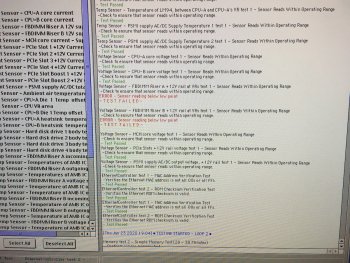I was recently given several 2006 Mac Pros and one of them is intermittently failing 2 tests that are part of the Apple Service Diagnostic suite. There is an error on the voltage sensors of both DIMM risers that reads as follows:
Voltage Sensor - FBDIMM Riser A + 12V rail and VRs test 1 - Sensor Reads Within Operating Range
-Check to ensure that sensor reads within operating range
ERROR - Sensor reading below low point
- T E S T F A I L E D -
Voltage Sensor - FBDIMM Riser B + 12V rail and VRs test 1 - Sensor Reads Within Operating Range
-Check to ensure that sensor reads within operating range
ERROR - Sensor reading below low point
- T E S T F A I L E D -
I've attached a photo showing this, as well.
I have run all tests dozens of times. These DIMM riser sensor tests fail intermittently, but not always. All other tests have passed every time.
Apple Hardware Test shows no problems with the system. The system also seems to operate normally, at least during my testing so far; macOS installs fine, software installs and runs, and so on, but this is no indication that the system will work reliably, long term.
The system has 4GB of RAM installed on (8) 512MB DIMMs. I removed both DIMM risers and cleaned them, and also unplugged and reseated all DIMMs, but as expected, this had no impact on the error.
I have two other identical Mac Pros and they do not exhibit this error.
Any suggestions for where the problem lies and how I might fix (if possible)? Many thanks.
Voltage Sensor - FBDIMM Riser A + 12V rail and VRs test 1 - Sensor Reads Within Operating Range
-Check to ensure that sensor reads within operating range
ERROR - Sensor reading below low point
- T E S T F A I L E D -
Voltage Sensor - FBDIMM Riser B + 12V rail and VRs test 1 - Sensor Reads Within Operating Range
-Check to ensure that sensor reads within operating range
ERROR - Sensor reading below low point
- T E S T F A I L E D -
I've attached a photo showing this, as well.
I have run all tests dozens of times. These DIMM riser sensor tests fail intermittently, but not always. All other tests have passed every time.
Apple Hardware Test shows no problems with the system. The system also seems to operate normally, at least during my testing so far; macOS installs fine, software installs and runs, and so on, but this is no indication that the system will work reliably, long term.
The system has 4GB of RAM installed on (8) 512MB DIMMs. I removed both DIMM risers and cleaned them, and also unplugged and reseated all DIMMs, but as expected, this had no impact on the error.
I have two other identical Mac Pros and they do not exhibit this error.
Any suggestions for where the problem lies and how I might fix (if possible)? Many thanks.


